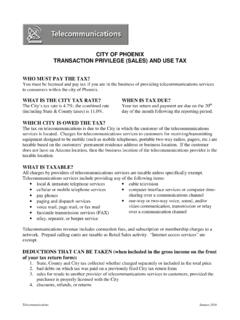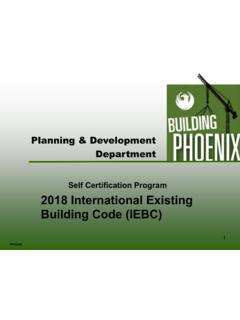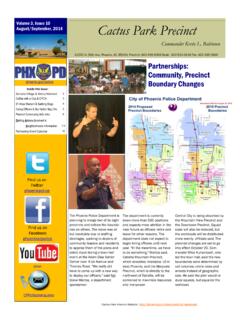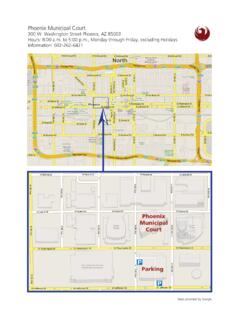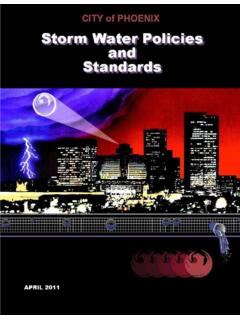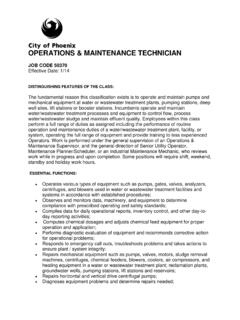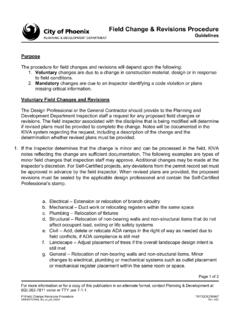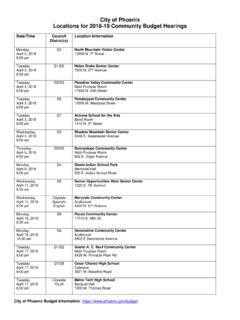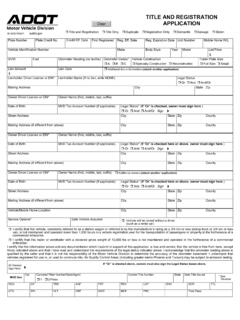Transcription of TRENCH RESCUE OPERATIONS - Phoenix, Arizona
1 PHOENIX REGIONAL STANDARD OPERATING PROCEDURES TRENCH RESCUE OPERATIONS 07/11-R PAGE 1 of 6 SCOPE This procedure establishes a standard structure and guideline for all fire department personnel operating at incidents involving TRENCH RESCUE OPERATIONS . The procedure outlines responsibilities for first-responders, TRT units, Command Officers, and other fire department personnel responding to such incidents. All other Phoenix Fire Department procedures shall apply to TRENCH RESCUE OPERATIONS where applicable.
2 PURPOSE The purpose of this procedure is to establish guidelines for the response of fire department personnel and equipment to TRENCH RESCUE incidents. Because TRENCH RESCUE OPERATIONS present a significant danger to fire department personnel, the safe and effective management of these OPERATIONS require special considerations. It shall be the policy of the Phoenix Fire Department that NO personnel shall be allowed into an unsafe TRENCH or excavation. This procedure identifies some of the critical issues which must be included in managing these incidents. TACTICAL CONSIDERATIONS OSHA Regulations Standard 29 CFR 1926 Subpart P regulates excavations for general industry and the RESCUE service and shall be considered the basis for emergency TRENCH RESCUE OPERATIONS .
3 For the purpose of emergency response, an excavation shall be defined by any depression, hole, TRENCH , or earth wall, man made or natural, of four feet or greater. TRENCH collapses generally occur due to unstable soil conditions combined with improper or inadequate shoring. The potential for additional collapse is considered a primary hazard to personnel. Removing soil or debris, adding weight near the edge of an open cut, vibration (such as vehicle movement), rain, or simply the passage of time, may cause additional collapse at any time during the RESCUE operation. Due to the inherent dangers associated with these OPERATIONS , the Phoenix Fire Department Risk Management Profile shall be applied to all TRENCH RESCUE OPERATIONS and shall be continuously re-assessed throughout the incident.
4 A phased approach to TRENCH RESCUE OPERATIONS which include; Arrival, Pre-entry OPERATIONS , Entry OPERATIONS , and Termination, can be utilized to safely and effectively mitigate these high-risk / low-frequency events. Additional technical information is available in the issued Technical RESCUE Field OPERATIONS Guide. PHOENIX REGIONAL STANDARD OPERATING PROCEDURES TRENCH RESCUE OPERATIONS 07/11-R PAGE 2 of 6 Phase I Arrival. I. ESTABLISH COMMAND A. First arriving company officer shall assume Command and begin an immediate size-up of the situation while ensuring that apparatus remains at least 50 feet from the location of the TRENCH failure.
5 Command shall announce that Level 1 staging should take place at least 150 feet from the TRENCH failure. B. First arriving TRT unit that is staffed with a TRT Company Officer should be assigned RESCUE Sector. The TRT Company Officer assigned as RESCUE Sector should remain with his crew. RESCUE Sector responsibilities include: Assuming technical RESCUE OPERATIONS control. Identifying hazards and critical factors. Developing a RESCUE plan and back-up plan. Communicating with and directing TRT resources assigned to RESCUE Sector. Informing Command of conditions, actions, and needs during all phases of the RESCUE operation.
6 C. Designate a Safety Officer. Considerations for Safety Officer include: One of the Regional Special OPERATIONS qualified Safety Officers. A Special OPERATIONS qualified Battalion Chief and/or FIT. Any experienced TRT Company Officer assigned to the incident. D. Following the transfer of Command to a Command Officer, a Technical Advisor should be assigned to join the Command Team at their location, to assist in managing personnel and resources engaged in the technical aspects of the incident. The Technical Advisor is responsible for ensuring that the RESCUE plan developed by RESCUE Sector and communicated to Command is a sound plan in terms of the safety and welfare of both victim(s) and rescuers.
7 Considerations for the Technical Advisor include: A Special OPERATIONS qualified Battalion Chief and/or FIT. One of the Regional Special OPERATIONS qualified Safety Officers. Any experienced TRT Company Officer assigned to the incident. The Technical Advisor position within the Command Team should be filled prior to the implementation of any RESCUE plan proposed by RESCUE Sector. PHOENIX REGIONAL STANDARD OPERATING PROCEDURES TRENCH RESCUE OPERATIONS 07/11-R PAGE 3 of 6 II.
8 Size-Up A. secure a witness or responsible party to assist in gathering information to determine exactly what happened. If no witnesses are present, Command may have to look for clues on the scene to determine what happened. B. Assess the immediate and potential hazards to the rescuers. C. Isolate immediate hazard area, secure the scene, and deny entry for all non- RESCUE personnel. D. Assess on-scene capabilities and determine the need for additional resources. Phase II Pre-entry OPERATIONS It must be determined if this will be a RESCUE operation or a RECOVERY operation based on the survivability profile of the victim(s) which include factors such as the location and condition of the victim(s), and elapsed time since the accident occurred.
9 I. MAKE THE GENERAL AREA SAFE A. Establish a hazard zone perimeter 50 feet from the collapse area. Keep all non-essential RESCUE personnel out of the hazard zone. Consider establishing Lobby to control RESCUE personnel entering the hazard zone. Remove all non-essential civilian personnel at least 150 feet away from the collapse area. B. Control traffic movement. Shut down roadway. Stage apparatus at least 150 feet from the collapse area. Re-route all non-essential traffic at least 300 feet from the collapse area. Shut down all heavy equipment operating within 300 feet of the collapse area.
10 II. MAKE THE RESCUE AREA SAFE These pre-entry OPERATIONS shall be conducted under the direction of RESCUE Sector by trained Technical RESCUE Technicians. A. Approach the TRENCH from the ends if possible. B. Look for unidentified hazards such as fissures or an unstable spoil pile. C. Assess the spoil pile for improper angle of repose and general raveling. D. Remove any tripping hazards from around the TRENCH . E. Place ground pads around the lip of the TRENCH . PHOENIX REGIONAL STANDARD OPERATING PROCEDURES TRENCH RESCUE OPERATIONS 07/11-R PAGE 4 of 6 F.
